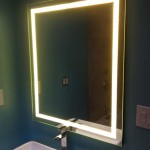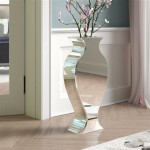Decorating a Room with a Mirrored Wall
Integrating a mirrored wall into a room's design can dramatically alter its perceived dimensions and ambiance. Mirrors possess the unique ability to reflect light and create an illusion of expanded space, making them a valuable tool in interior design, especially for smaller rooms or spaces with limited natural light. However, careful planning and consideration are essential to ensure the mirrored wall enhances the overall aesthetic rather than creating a distracting or overwhelming effect.
Choosing the Right Mirror Type
The selection of the mirror itself plays a crucial role in the final outcome. Various types of mirrors are available, each offering distinct characteristics. Large, single-pane mirrors create a seamless, expansive look, while mirrored tiles or panels provide a more textured and dynamic surface. Antique mirrors, with their subtle imperfections and aged patina, can add a touch of vintage charm to a space. The choice of mirror type should align with the room's overall design style and the desired atmosphere.
Placement for Optimal Impact
Strategic placement is key to maximizing the benefits of a mirrored wall. Positioning a mirror opposite a window or light source can amplify natural light and brighten the room considerably. Reflecting a visually appealing area, such as a well-decorated wall or a garden view, can create a sense of depth and interest. Avoid placing mirrors directly opposite doors or high-traffic areas, as this can lead to distracting reflections and potential collisions.
Framing and Finishing Touches
While frameless mirrors offer a clean and modern look, adding a frame can enhance the mirror's presence and tie it into the room's décor. The frame material and style should complement the existing furnishings and overall design theme. Consider incorporating decorative elements around the mirrored wall, such as wall sconces or artwork, to create a balanced and visually appealing composition. However, avoid over-cluttering the surrounding area, as this can detract from the mirror's reflective qualities.
Considering the Room's Function
The purpose of the room should influence the design choices related to the mirrored wall. In a dining room, a mirrored wall can create a sense of grandeur and enhance the social atmosphere. In a bedroom, a mirrored wall might be placed behind a dresser or vanity, adding functionality and style. In a living room, a strategically placed mirrored wall can amplify the space and create a focal point. Careful consideration of the room's function will help ensure the mirrored wall complements its intended use.
Balancing Reflection and Absorption
While mirrors reflect light, they also reflect sound. In rooms where sound control is important, such as bedrooms or home theaters, it's essential to balance the reflective surface of the mirrored wall with sound-absorbing materials. This can be achieved by incorporating soft furnishings, such as rugs, curtains, and upholstered furniture, to dampen sound reflections and create a more balanced acoustic environment.
Maintenance and Care
Maintaining the pristine appearance of a mirrored wall requires regular cleaning. Use a soft, lint-free cloth and a gentle glass cleaner to remove fingerprints, dust, and smudges. Avoid using abrasive cleaners or materials that can scratch the mirror's surface. Regular cleaning will ensure the mirrored wall continues to enhance the room's aesthetics and reflect light effectively.
Integrating with Existing Decor
A mirrored wall should seamlessly integrate with the existing décor. Consider the color palette, furniture styles, and overall design theme of the room. The mirror's frame, if any, should complement the other finishes in the space. The reflected elements should contribute to the overall aesthetic rather than clashing with it. A well-integrated mirrored wall will enhance the room's design, creating a harmonious and visually appealing space.
Addressing Potential Drawbacks
While mirrored walls offer numerous benefits, they also present potential drawbacks. Mirrors can amplify clutter and imperfections, so maintaining a tidy and organized space is essential. Overuse of mirrors can create a disorienting or overwhelming effect. Careful planning and consideration of these potential downsides can help ensure a successful integration of a mirrored wall into a room's design.

Image Gallery Page 426153183488350696 Artofit Hall Decor Interior Wall Design Living Room

15 Photogenic Feature Wall Designs That Can Make Your Home Stand Out Design Mirror Decor Living Room Interior

Mirror Decoration For Home 15 Ideas To Decorate With Mirrors

Wall Mirror Design Ideas For Your Home Cafe

Modern Bedroom Decor With Mirrors Mirror Design

How To Decorate With Mirrors Decorating Ideas For

Mirror Decoration Ideas For Living Room Doğtaş

How To Decorate With Mirrors Decorating Ideas For

Colourful Organic Design In North Coogee Home Decor Collected Interiors House Interior

Mirror Decoration For Home 15 Ideas To Decorate With Mirrors








